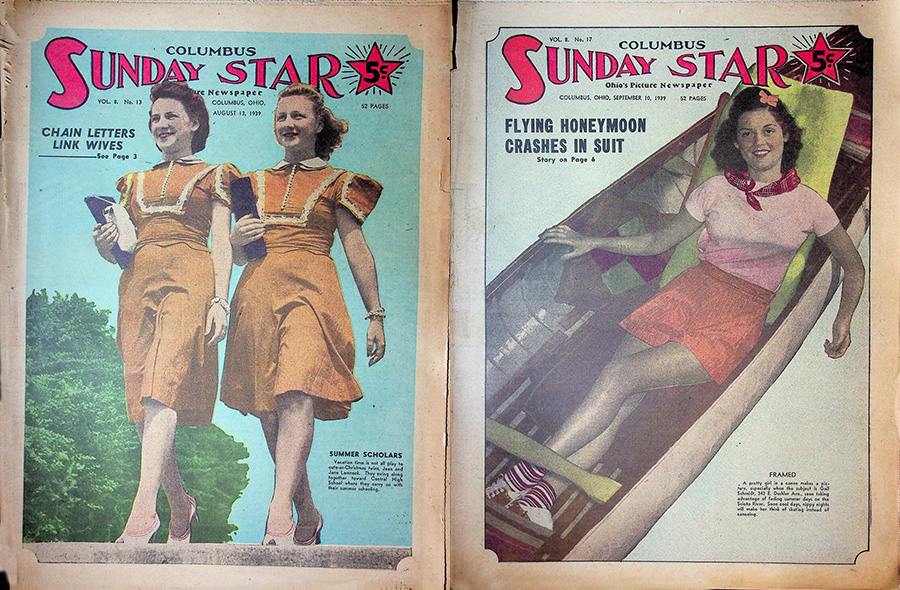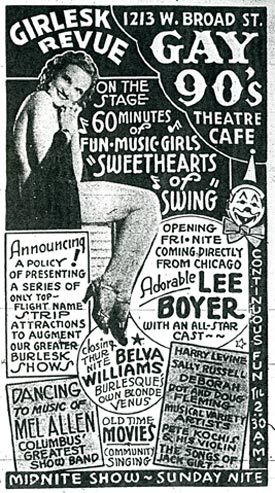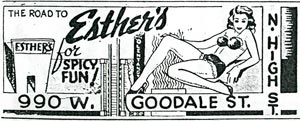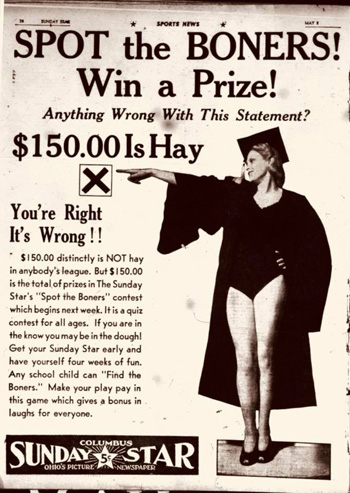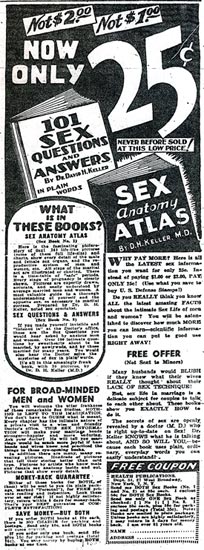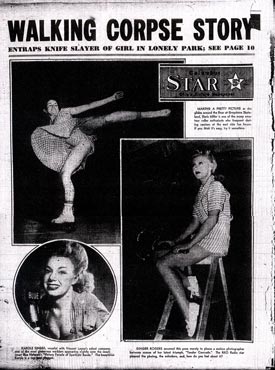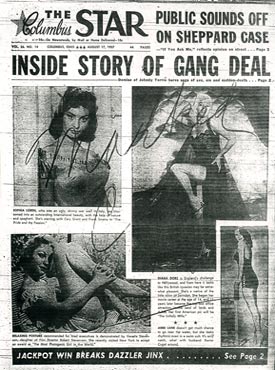Pretty local girls--of course--on the covers of the Aug 13 and Sep 10, 1939 editions of the Sunday Star. |
||
|
The entertainment beat came next: star photos (preferably girls, preferably in swimsuits or less), movie stills, and essentially unedited promotional fluff from movie press packets and stars' agents. The Star attended carefully to Hollywood gossip and scandals. It chronicled moral outrage at those sinful Hollywood actors and actresses and always detailed the specific outrageous acts they engaged in. An article from 1933, Sin and Sex Pervade Popular Songs, is typical. Lyrics to many popular songs, the article charged, were no different than "brothel ballads." So you could judge for yourself, the paper printed some of the offending lyrics. Front and center in the half-page photo accompanying the article--right between Mae West and Jean Harlow--was that lascivious crooner Bing Crosby. Despite this concern for morality, The Star had a special relationship with the city’s burlesque houses. Local burlesque girls were frequently featured on the paper's front page. The Lyceum in the early 1930s, Esther’s, Arabian Gardens, Gay 90s, and the Parisian Revue in the later 1930s and 40s, and the Gayety in the 1940s and 50s figured prominently but they even had strip revues down at the RKO Palace and other respectable venues. When pretty peelers were taking it off, The Star could be counted on to print photos, run ads, and work up an article.
The Star also attended carefully to the city's nightclubs, running reviews, photos, promotional pieces, and tons of ads--like a Columbus Alive or Other Paper of its day. |
|
 |
|
|
The Star’s 40 page length was rounded out with features, photos, and fiction. Advice columns and astrology were popular. San Francisco's notorious Count Marco with (terrible) advice for women was in there. Hobby and outdoors columns were reader favorites. There was also an exercise column with photos of lightly attired, shapely models demonstrating exercises that almost always seemed to aim at enhancing the bust. In the 1950s and early 1960s, pop prognosticator and Ed Wood crony Criswell’s column was carried by The Star. The Star loved gossip. Tattle Tales by "Paul Pry" was a feature of The Star from the first issue to the last. Tattle Tales was like a Facebook of its day, announcing who got a job, got promoted, moved, bought a house, took a vacation, married, divorced, had a baby, etc. Pretty mundane stuff really but somehow the writers made it sound more interesting than it actually was. To spice it up, some showbiz gossip was often stirred in. Of particular interest to the University District was Tattle Tales' college cousin, Campus Cuffnotes. The Cuffnotes feature dwelt heavily on the fraternity and sorority scene and focused on who was with who, who was cheating, who'd broken up, who broke them up, who was pinned, who was engaged, and who'd gotten married. Special attention was given to athletes and other campus celebrities. Cuffnotes was written by moonlighting student reporters from The Lantern. Contests and puzzles were a huge part of The Star's appeal. The pitch to readers was simple: read The Star, win cash. From the very beginning, The Star ran contests to caption photos or cartoons and offered cash prizes for the best. There was a lucky numbers contest that was a lot like a lottery. The Star also sponsored a Miss Central Ohio beauty contest (finalists selected by readers from printed photos) with a Florida vacation prize. The Dollar Dazzler was the paper's most popular contest. Readers worked a crossword puzzle and mailed it in. The entrant who got the puzzle correct got $100--unless nobody got it right. Then the prize went up by $25 for the next week's puzzle. Sometimes the prize climbed above $500, occasionally above $1,000. |
Somewhere in the mix would be a photo centerfold--The Star was "Ohio's Picture Newspaper" after all. This would consist of cheesecake shots of local girls (The University District was well-represented), half-naked Hollywood models and starlets, more burlesque girls, gory crime scene shots (Think Weegee) accident photos (Think Signal 30), notorious criminals, and popular athletes. The Star had a mascot, Colonel Elmer Blupe. Blupe was a portly, balding fellow with an absurd handlebar moustache and a passion for lovely ladies. His comic adventures were a frequent Star feature. Blupe was involved in photo mysteries; comic scenes with pretty, barely dressed girls, and short photo travelogues. Serial fiction appeared in The Star for most of its run. A long-running fiction series in the 1930s followed the amorous adventures of "Columbus' Public Sweetheart No. 1" from Bexley High School through her college days at Ohio State. Each issue carried yarns with teasing titles like "Blond Trouble," "Secondhand Sweethearts," ”Summer Love,” and “Band Wife.” These stories were more character sketches than actual stories. Nothing much really happened in any of them. Mostly they just described scheming, fast-living vamps and the evil things they did to the men foolish enough to love them or the cold, greedy old men who married pretty, vivacious, young wives for trophies and then neglected them. Many were penned by Jack Lait, editor of The New York Daily Mirror and a pioneer of the tabloid genre. Occasionally, The Star broke form with an adventure, historical romance, war, or even science fiction story like "When Worlds Collide." The Star carried a lot of local ads but not like the other papers. There were no classifieds. There were no ads from Lazarus, Sears, or Penneys, no weekly specials from Big Bear or Krogers. Instead there were ads for beauty shops, garages, restaurants, discount jewelers, bargain clothiers, easy credit furniture stores, and lots and lots of entertainment and nightclub ads. In the back pages of The Star was advertising for out-of-town firms offering unusual goods and services—often of a sexual nature—not easily attained elsewhere. The same stuff as the pulps! Psychics, mediums, trusses, miracle oil treatments, impotence cures (including something called Monkey Powder), cures for late periods, French postcards, saucy books, and those little comic books that gals are supposed to like too figured prominently. Books of sexual instruction were also prominent advertisers, promising to produce lasting, blissful unions for their readers by abolishing “sex ignorance.” Of course to achieve this lofty, pro-family goal these manuals couldn’t be fettered by prudishness. They had to show all and tell all. One imagines that this constituted a significant part of their allure. |
|
The Star in 1943. |
The Star was The Star in the 1930s and 1940s. By the dawn of the 1950s, it began to change. The country was changing. The upheaval of the Great Depression, the Second World War, and the soldiers' return home were fading into the past. America was focusing on 9-to-5 jobs, home-and-hearth, raising children, nuclear families, suburbia, shopping malls, traditional values, and television. The Star's gritty urban world of showgirls and slayers was out of step with the times. To stay in business The Star changed. Crime, scandal, and sex coverage was dialed way back--but not eliminated. Nudes and partial nudes disappeared from The Star's pages. (Although a bikini girl reliably appeared on page 3 until the bitter end.) Sports, TV listings, columns, housekeeping tips, contests, puzzles, and wholesome entertainment pieces took their place. The Star of the 1950s and 60s labored to be positive, upstanding, and family-oriented. |
The Star in 1957. |
|
Meanwhile, television became a potent competitor to newspapers. This was a problem especially among the low-education readers where tabloids found most of their audience. TV provided the entertainment and information the newspaper formerly had and provided it for free. Through the early 1960s, the writing was on the wall. The comics section slimmed then disappeared. The paper's page count got smaller. Local features were almost entirely replaced with cheaper syndicated material. By the end, The Star wasn't much more than a wrap-around for the TV listings. On December 26, 1965, the paper published its last issue. |
|||
|
|||
|
|||

